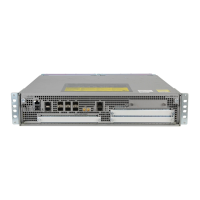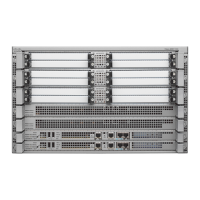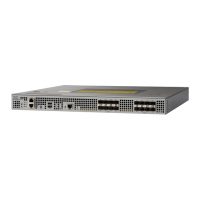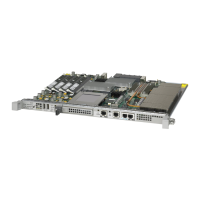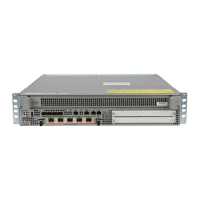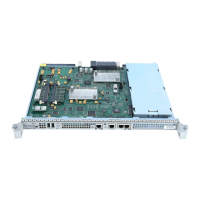7-4
Cisco ASR 1000 Series Aggregation Services Routers SIP and SPA Software Configuration Guide
OL-14127-08
Chapter 7 Configuring the ATM SPAs
Configuration Tasks
Specifying the Interface Address on a SPA
Up to four ATM SPAs can be installed in a SIP. SPA interface ports begin numbering with “0” from left
to right. Single-port SPAs use only the port number 0. To configure or monitor SPA interfaces, you need
to specify the physical location of the SIP, SPA, and interface in the CLI. The interface address format
is slot/subslot/port, where:
• slot—Specifies the chassis slot number in the Cisco ASR 1000 Series Router where the SIP is
installed.
• subslot—Specifies the secondary slot of the SIP where the SPA is installed.
• port—Specifies the number of the individual interface port on a SPA.
The following example shows how to specify the first interface (0) on a SPA installed in the first subslot
of a SIP (0) installed in chassis slot 3:
Router(config)# interface serial 3/0/0
This command shows a serial SPA as a representative example, however the same slot/subslot/port
format is similarly used for other SPAs (such as ATM and POS) and other non-channelized SPAs.
For more information about identifying slots and subslots, see Chapter 4, “Identifying Slots and Subslots
for the SIP and SPAs”.
Modifying the Interface MTU Size
The maximum transmission unit (MTU) values might need to be reconfigured from their defaults on the
ATM SPAs to match the values used in your network.
Interface MTU Configuration Guidelines
When configuring the interface MTU size on an ATM SPA, consider the following guidelines.
The Cisco IOS software supports several types of configurable MTU options at different levels of the
protocol stack. You should ensure that all MTU values are consistent to avoid unnecessary fragmentation
of packets. These MTU values are the following:
• Interface MTU—Configured on a per-interface basis and defines the maximum packet size (in bytes)
that is allowed for traffic received on the network. The ATM SPA checks traffic coming in from the
network and drops packets that are larger than this maximum value. Because different types of Layer
2 interfaces support different MTU values, choose a value that supports the maximum possible
packet size that is possible in your particular network topology.
• IP MTU—Configured on a per-interface or per-subinterface basis and determines the largest
maximum IP packet size (in bytes) that is allowed on the IP network without being fragmented. If
an IP packet is larger than the IP MTU value, the ATM SPA fragments it into smaller IP packets
before forwarding it on to the next hop.
• Multiprotocol Label Switching (MPLS) MTU—Configured on a per-interface or per-subinterface
basis and defines the MTU value for packets that are tagged with MPLS labels or tag headers. When
an IP packet that contains MPLS labels is larger than the MPLS MTU value, the ATM SPA
fragments it into smaller IP packets. When a non-IP packet that contains MPLS labels is larger than
the MPLS MTU value, the ATM SPA drops it.
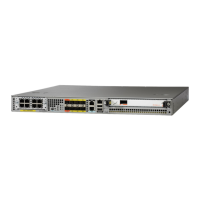
